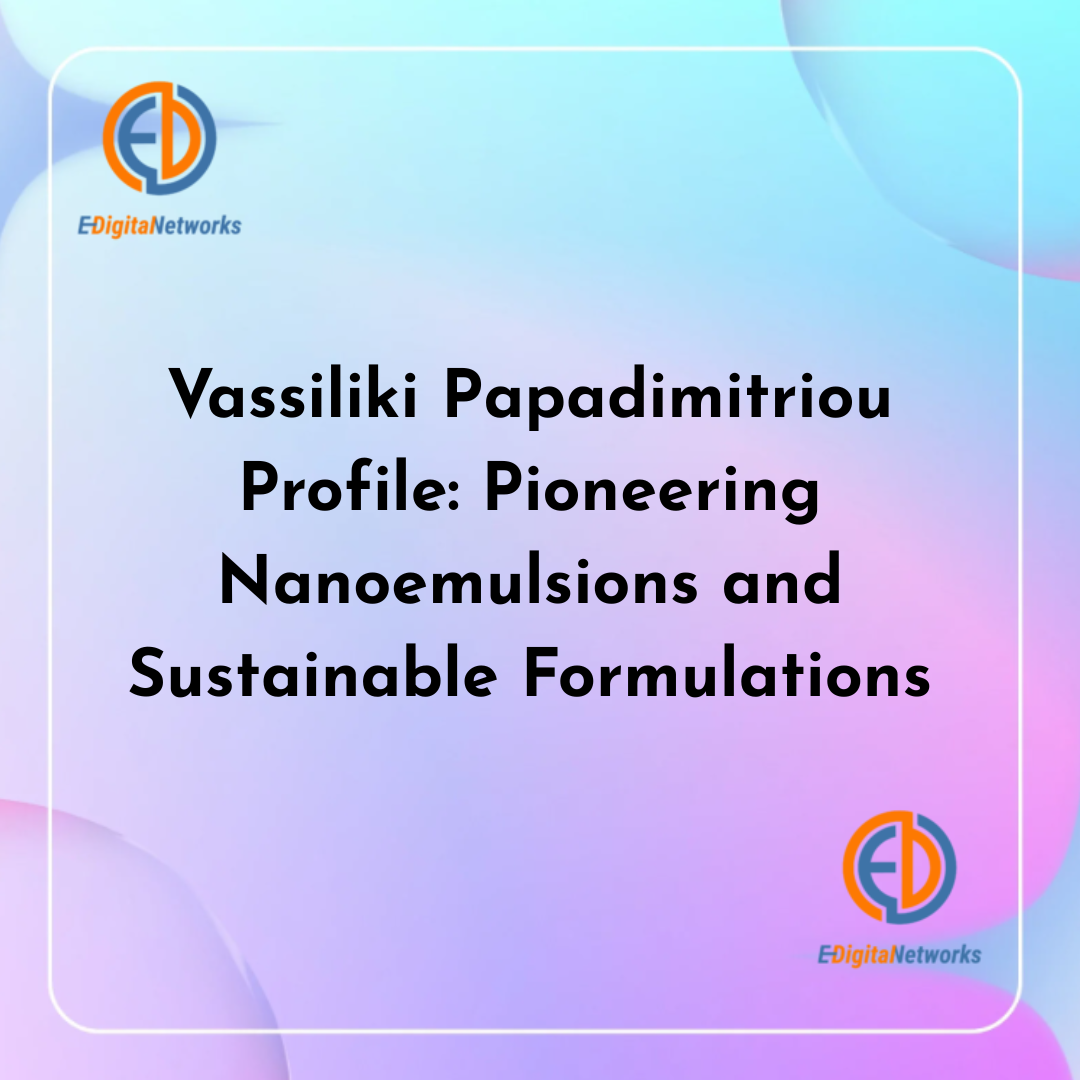With over thirty years of arduous academic study and innovative research at the National Hellenic Research Foundation (NHRF), Vassiliki Papadimitriou is at the forefront of colloidal biochemistry and nanotechnology. From her early interest in enzyme kinetics to her innovative work on nanoemulsions, her career is a prime example of how basic research can be combined with real-world applications to improve cosmetics, medicines, and agriculture. Vassiliki received her education at the National and Kapodistrian University of Athens, where she obtained her PhD in biochemistry. She strengthened her knowledge via professional growth through EMBO workshops and postdoctoral fellowships throughout Europe.
She oversees multidisciplinary teams at the NHRF’s Institute of Biology, Medicinal Chemistry, and Biotechnology that are dedicated to creating cutting-edge delivery methods and investigating the molecular processes underlying lipid peroxidation. While her advances in nanoemulsion design open the door to more effective medication administration to the central nervous system, her work on electron spin resonance spectroscopy has provided insight into the behavior of free radicals in non-aqueous fluids. She promotes mentoring outside of the lab, creating a cooperative atmosphere that unites industrial partners, biotechnologists, and chemists.
From Vassiliki Papadimitriou’s educational background and core research areas to her most referenced papers, continuing initiatives, and lessons for aspiring scientists, this extensive blog explores 10 crucial issues about her life story. Join us as we examine the life, work, and legacy of a real pioneer in nanoemulsion technology, regardless of whether you are an early-career researcher or just interested in the nexus between science and innovation.
Who Is Vassiliki Papadimitriou?
Senior researcher Vassiliki Papadimitriou leads teams at the NHRF in Athens, Greece. Having more than thirty years of experience, she has been known as a guru on free radical chemistry, microemulsions, and nanoemulsions.
Under her direction at the Institute of Biology, Medicinal Chemistry, and Biotechnology, PhD students are mentored, worldwide projects are coordinated, and academic research is bridged with industry uses. Renowned for her strict methodology and multidisciplinary teamwork, she has raised Greece’s profile in world colloid science.
What Are the Key Research Areas of Vassiliki Papadimitriou?
Vassiliki’s main areas of study include advanced spectroscopic methods, oxidative stability studies of lipids, and the formulation and characterizing of nanoemulsions and microemulsions. She looks at how drug encapsulation efficiency, skin penetration, and controlled release change with surfactant composition and droplet size.
Her study on lipid peroxidation concurrently uses electron spin resonance to measure free-radical production, therefore guiding food preservation techniques and cosmetic antioxidant formulations. These twin interests highlight her dedication to translational results as well as basic science.
Where Did She Receive Her Education and Training?
Emphasizing enzyme kinetics and magnetic resonance techniques, Vassiliki obtained her PhD in biochemistry from the National and Kapodistrian University of Athens. Her technical skill set grew with postdoctoral fellowships at the Technical University of Denmark and joint trips to research facilities in France and Germany.
She has always attended EMBO seminars and summer courses to make sure her knowledge stays at the forefront of bio‑nano research. Her whole research viewpoint has been formed by this mix of formal education and foreign experience.

How Has Vassiliki Papadimitriou Advanced Nanoemulsion Technology?
Vassiliki’s group obtained nanoemulsions with impressively homogeneous droplet dispersion below 100 nm by methodically tweaking surfactant blends and processing settings. These formulations improved the bioavailability and stability of encapsulated molecules including UV-filtering chemicals and curcumin.
Cosmetic and pharmaceutical businesses have embraced her scalable high-pressure homogenization and microfluidization techniques, which improve effectiveness and lower manufacturing costs. Her efforts define new standards for ecologically sustainable, safe, and effective nanoemulsions.
What Impact Has Her Work on Lipid Peroxidation Had?
Vassiliki counted free-radical species in extra virgin olive oil under many storage settings using electron spin resonance spectroscopy. Her research guided best-practice recommendations for manufacturers, therefore enhancing shelf life and nutritional value.
When setting antioxidant labeling criteria, EU regulatory authorities have consulted her data. She closed the gap between laboratory research and commercial application by turning difficult spectroscopic data into practical advice.
How Extensive Is Her Publication Record?
Vassiliki’s publishing record displays both depth and breadth with over 70 peer-reviewed publications and more than 1,800 citations. Her most often mentioned publications in non-aqueous media address microemulsion structural characterization, reactive oxygen species scavenging, and enzyme-catalyzed reactions.
Regular contributions to top publications in colloid and interface research highlight her leadership role. This large-scale production still inspires fresh study in colloidal biochemistry and has shaped research paths all around.
What Awards and Recognitions Has She Received?
Though not usually publicized, Vassiliki’s colleagues have honored her with invitations to join editorial boards of prestigious publications and to deliver keynote speeches at significant conferences like the European Colloid and Interface Society Meeting.
These roles respect her knowledge and colloid science leadership. She has also obtained competitive grants from national funding bodies and Horizon Europe, evidence of her reputation for producing highly significant research results.

How Does She Collaborate With Global Research Networks?
Vassiliki keeps active alliances all throughout Europe and North America, including cooperative initiatives between the Agricultural University of Athens and the University of Massachusetts Amherst. She co-develops biodegradable surfactants and investigates enzyme-catalyzed reactions in reverse micellues using Horizon Europe consortia.
These partnerships promote technological transfer, capacity development, and the cross-pollination of ideas between industrial and academic labs.
What Are Her Ongoing Projects and Future Directions?
With preclinical studies scheduled to start in late 2025, current efforts center on parenteral nanoemulsions meant for tailored distribution to the central nervous system.
Aiming to lower the environmental effect of commercial formulations, she simultaneously oversees a multi-institutional project to produce biodegradable surfactants derived from olive industry leftovers. These initiatives embody her idea of combining sustainability with scientific creativity.
What Lessons Can Aspiring Researchers Learn From Her Career?
The path Vassiliki takes emphasizes the need of mentoring, tenacity, and multidisciplinary thinking. Among the important lessons include adopting strict analytical methods, working internationally, and matching studies to practical demands.
Her servant-leadership style—which gives team development and open communication first priority—offers a paradigm for creating inclusive and efficient lab environments. Her experience shows aspiring scientists that combining scientific brilliance with social influence results in both personal fulfillment and general advantages.
Conclusion
The great career of Vassiliki Papadimitriou reflects the confluence of basic science and useful application. She has enhanced our knowledge of colloidal systems and promoted sustainable innovation by means of pioneering nanoemulsion technologies, in‑depth lipid peroxidation investigations, and devoted mentoring. Her all-encompassing approach—balancing rigorous testing, multidisciplinary teamwork, and a vision for society’s good—may inspire future researchers. Her legacy still shapes both industrial operations and bio‑nano research going forward.

